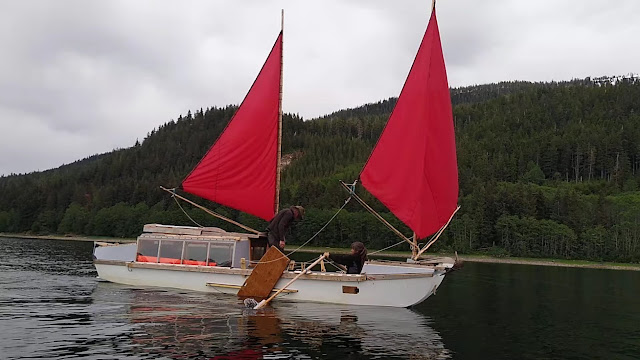 |
| Illustration by Caroline Magerl of Queensland, Australia From The Epoxy Book |
Caveat Emptor (Buyer Beware)!
Buying or Selling a Vessel? Tips, Tricks and Traps
The market is a slippery, tricky place. Theory is that parties negotiate until they come to mutual agreement. Win-win. Everybody goes home happy. Another view is that it’s an adversarial contest. The seller wants the highest price, while the buyer wants the lowest. All’s fair in love and war.
One piece of advice I was given; Back off at the first whiff of adversity (pressure, hustle, prevarication, coercion).
If we’re not dealt with in good faith, we’re likely to get cheated or stiffed. On the seller side, I’ve witnessed transactions which include hidden issues, false provenance (the seller didn’t wholly own the vessel), listed gear being stripped after sale. I’ve known buyers to skip payment/s, abscond with gear that wasn’t included in the agreement, wreck the boat and skip town.
Much better to negotiate amicably for that win-win. The waterfront is a small world, and it’s good business to make and keep friends.
Four Traps for Buyer and Seller
These traps don't themselves signal adversity. We’re all human, and these kinds of things often creep in somewhat below the conscious level.
Sentimental Value – Sellers often factor their sentimental feelings into a vessel’s price. This, despite the fact that they are never-the-less unloading their Loved One on the market. No issues with their fond memories, of course, but those have zero market value.
By the same token, our own sentimental attachments can likewise serve to jack up the price. We’re suckers for pretty, cute, trim, traditional and a host of other impressions which bias our neutral assessment. Rot, nail-sickness, blisters and other infirmities might be lurking… beauty is only skin-deep!
They say one shouldn’t sleep aboard a vessel before buying, lest one fall in love. Not sure I’d go that far – we want to be in love – but keep a clear, cold eye on how much you’re willing to pay for it! Consider a professional survey as a reality check.Sunken Costs – Closely related, seller’s often wish to make up previous expenses, which have nothing to do with the buyer. Dock and haulout fees, for example. Sellers often wish to recoup their costs, which often ends up on the buyer’s tab.
Issues – Just as in buying a house, issues may be dealt with before or after sale, with the price reflecting the agreement.
Consider a well-written contract based on industry standard templates that spells it all out. Handshake agreements are well-and-good for simple cases, but a fully found vessel is complex by nature, with lots of room for mis-understanding and animosity.Potential Value – Once you’ve fixed ‘er up, you’ll have doubled yer money! Um. Well. You might double the price when you come to sell, but that doesn’t automatically count the time, materials, labor and fees you’ll have supplied.
The value of a vessel is ‘as is’, not ‘as it might become’.New Prices for Old Gear – Yes, the price is high, but look at that gear list! Think of the replacement value…
Hmm… that gear is not only used, but has been sitting around in the marine environment. It likely does have value (obsolete gear doesn’t count), but it won’t be the replacement value.
*****
Assigning value is extremely difficult. Supply-and-demand gets us started, but in the world of vessels, supply is very often low (unique or uniquely available vessels), while demand is… personal.
Cost is somewhat easier to calculate:
Consider the state of the vessel as is… take a goooood look!
Consider the time and energy required to repair and outfit to your standard.
Consider the time and energy required for long-term maintenance, including moorage.
Consider alternative options.
If your total cost from all the above plus the price you can negotiate is greater than you can afford or are willing to pay, it’s no-go.
Buyers, consider doing as much of this calculation as you can before starting negotiations… no point wasting the seller’s time and your own if it’s a non-starter.
Good luck, and win-win!










